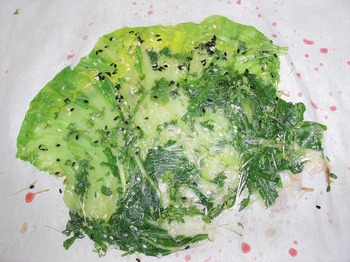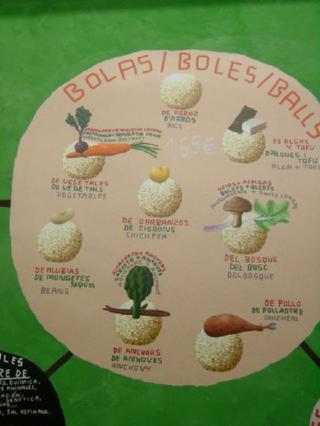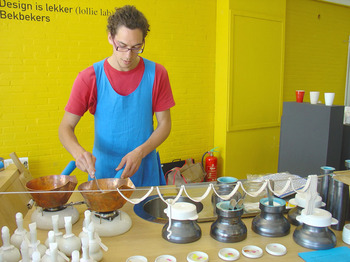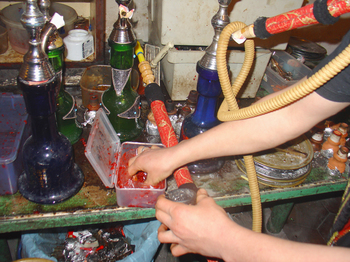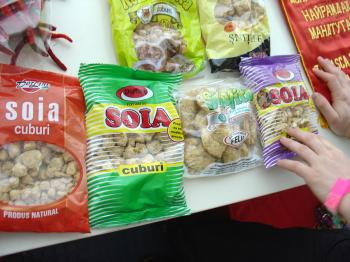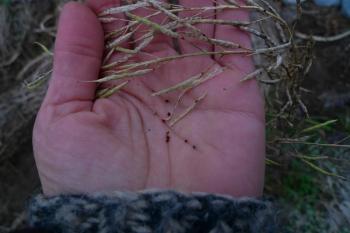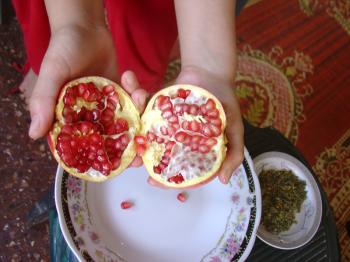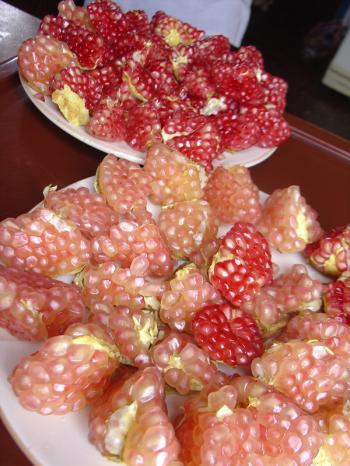Communauté Choucroute, Community Pickle,
a proposal
October 30, 2008
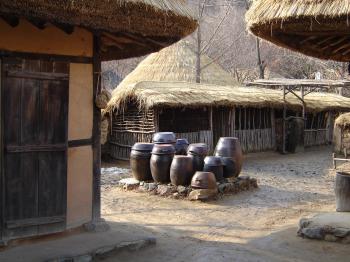
Jangdok are onggi or earthen jars storing jang (condiments) such as gochujang (chili pepper condiment), doenjang (soybean paste), ganjang (Korean soy sauce) or kimchi. Image from Save the Dinosaur’s photostream and used entirely without permission.
The following is a statement about food storage that I will be presenting this year as part of John Thackara’s City Eco Lab at the Cité du Design Biënale in Saint-Étienne (Nov 15-30, 2008). Chef Paul Freestone and I will be pickling, sauerchocrouting and making delicious kimchi as one part of the installation. Please come visit the exhibition and taste what I’m proposing for the resilience of our communities.
Food sovereignty refers to the right of people to define and to have access to their own food and agriculture systems in contrast to having food largely subject to international market forces or defined by the dynamics of industrial food production. Designing community food storage into our cities and towns has enormous potential to reduce waste, shorten supply chains and on a socio-cultural level improve our communities.
Start imagining public food storage as part of urban masterplans, how it could look (and smell) and what it would mean in terms of activity and focus for the community. Before you discount this notion as completely comical, are you aware of how your community stores its food presently, how resilient it is in case of damage to the transport network, market forces, or how dependent your food is on foreign resource supplies?
In Europe, our backup food supply is most often stored en route, in trucks on the road. The fermented vegetable installation and demonstration, Communauté Choucroute is a proposal inspired by places in Asia where pickled vegetables are stored in beautiful ceramic vats in the open air, in the public space, ready for when you need it.
For greater food sovereignty, let’s store food around us, in our communities.
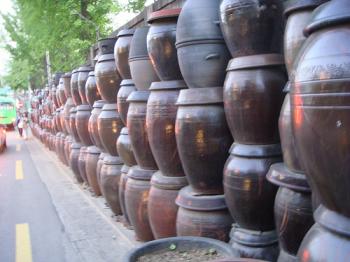
Kimchi pots stored along the side of a busy road, image from Jwh8a’s photostream on FlickR and used entirely without permission.
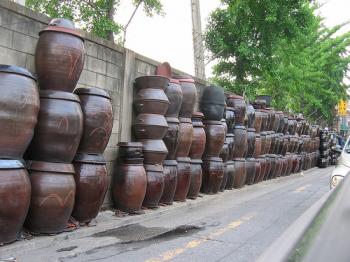
Kimchi pots stored along the side of a busy road, image from AtDawnWeRide’s photostream on Flickr and used entirely without permission.
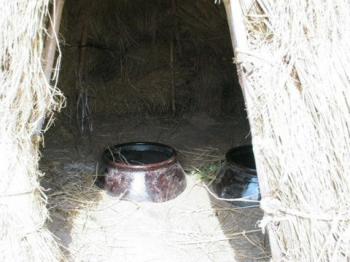
Kimchi pots buried in straw, image from Makigama’s photostream on Flickr and used entirely without permission.
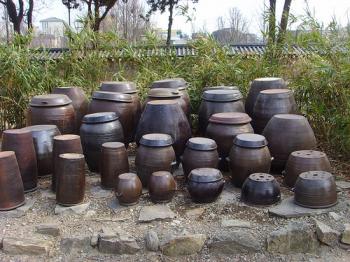
Kimchi pots aka onggi displayed as a choir, image from mmgutz16’s photostream on Flickr and used entirely without permission.
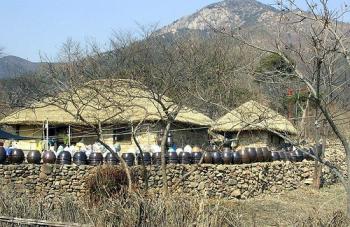
Kimchi pots lining the periphery of a folk village, image from Carpe Feline’s photostream on FlickR and used entirely without permission.
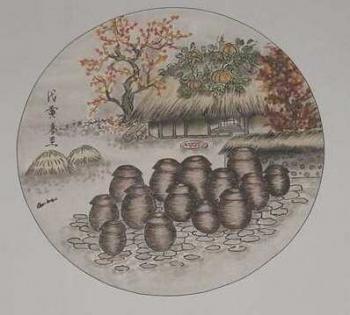
Pen and ink drawing of kimchi pots stored in the public space and pumpkins growing on a thatched roof. Photo snapped by Carpe Feline and used entirely without permission.
-
Save the Dinosaurs photostream on Flickr - images of a.o.t. a visit to a folk village and of course some kimchi pots being stored in the village square.
Jwh8a’s image of kimchi pots on Flickr.
AtDawnWeRide’s photostream on Flickr - kimchi pots stored and stacked alongside the road.
Makigama’s photostream on Flickr - a ceramophile and kimchi-o-phile
debra at 16:48 | Comments (1) | post to del.icio.us
A Kimchi Sunday
October 27, 2008
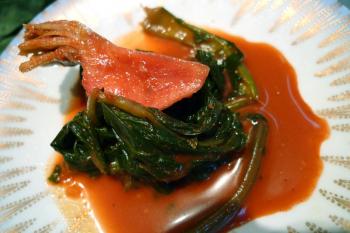
Turnip and turnip leaf kimchi in a pool of sauce shaped like the silhouette of a kimchi-lover
Community/Communauté Choucroute is one of my proposals at the City Eco Lab in Saint-Étienne for the Design Biennial this November. Designing resilience into urban food systems is essential, and one way to achieve this is to store food en plein public. There’s precedence in the salted and/or pickled cabbage installations centered in traditional villages and along the roadside in parts of East Asia.
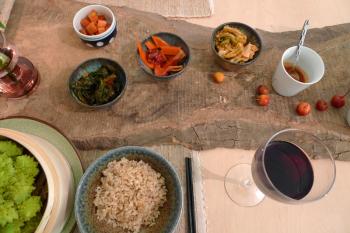
Kimchi array from l to r: daikon cubes, turnip greens, carrots and chard stems, chinese/napa cabbage, kimchi juice for extra rice lubrication
In preparation for the installation/demonstration of Communauté Choucroute, I’ve been experimenting with different fermented vegetable recipes. And when my landscape-architect friend Jacques decided that our shared passion for Korean pickled cabbage/kimchi as a way of spending a Sunday for us to get better acquainted, it was nothing short of prescient. Jacques prepared an exquisite workshop for us that included an instructional video from our online mentor Maangchi and all manner of traditional kimchi vegetables.
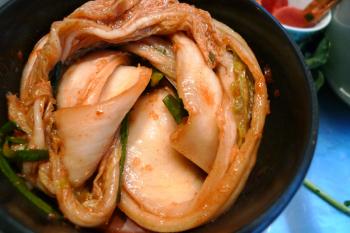
Classic chinese/napa cabbage kimchi
Although I’ve been making kimchi for decades, in my laziness I had resorted to using a pre-fab Korean kimchi paste from the Chinese supermarket. The flavours were good on their own, but not like the kimchi from a great Korean restaurant. Jacques introduced me to the ease of preparing the kimchi paste myself and an easier, faster recipe. Pardon my sounding like an advert when I gush that the results were astounding - perfect kimchi, 100% authentic flavour, in a fraction of the time. It’s like when you figure out how to roll your own pasta in 20 minutes, there’s no going back to storebought. Within a day our kimchi was bubbling away with a flavour so rounded with umami that I feel inspired to open up a kimchi boutique. The new secret ingredient? Chopped up raw oysters and all the sweet oyster juices. I am certain that it’s this enzyme-rich liquor that together with the lacto-bacilli-beasties transforms mere rotting vegetable matter into the champagne of cuisine vegetal.
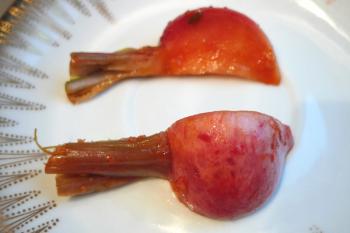
Kimchi turnips like jewels on a plate.
-
Maangchi’s instructional kimchi video
Culiblog’s step by step kimchi on Flickr
Valuable information and beautiful images from the Nation of Kimchi
debra at 11:49 | Comments (8) | post to del.icio.us
A Light Year
October 6, 2008
In the past year, interesting projects that would yield so much content for Culiblog occupied me such that it was difficult to find time to write about them at all. Thankfully it’s the very first days into the New Year, a time for a resolution or two, one about more frequent and lighter blog postings, fueled by the memory of how energizing that used to be.
Here’s to a Light Year, easy to enjoy!
Shana Tova to you all.
- The nine day period between Rosh Hashanah (the Jewish New Year) and Yom Kippur (the Jewish Day of Atonement) is called the Days of Awe, a time when we reflect, resolve and get ready for one big day of forgiveness and forgiving.
Good luck with that, by the way.
Here’s my favourite pomegranate-based recipe to lighten the load. It’s no coincidence that the Hindu holiday of Narvratri (the Nine Nights) and the Jewish Days of Awe fall at the same time as both cultures are enamoured with their adjusted lunar calendars.
During Navratri devout Hindus eat a strictly vegetarian diet, and depending on where you source your information and authority, devout Jews are asked to do the same - to lead a sober life, for example by not wearing any leathuh.
Here’s to a Light Year with plenty of joyous Cuisine Végètal.
debra at 14:33 | Comments (0) | post to del.icio.us

